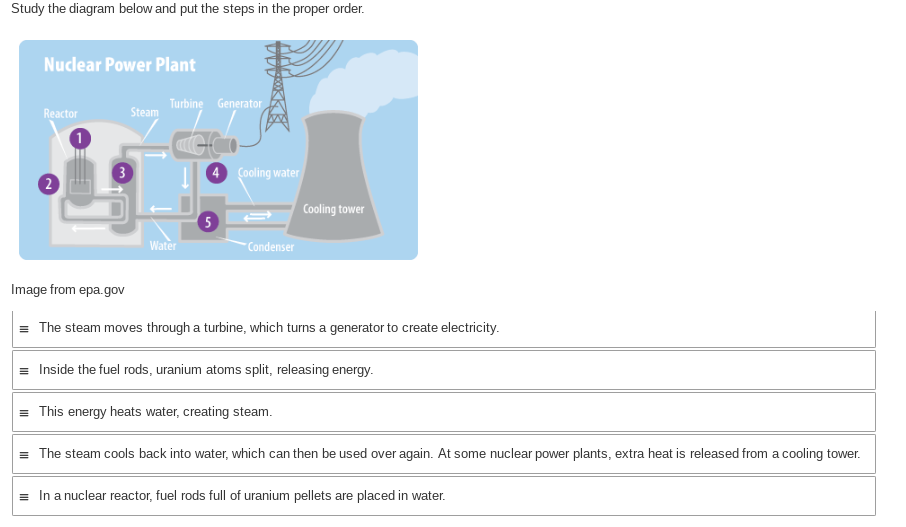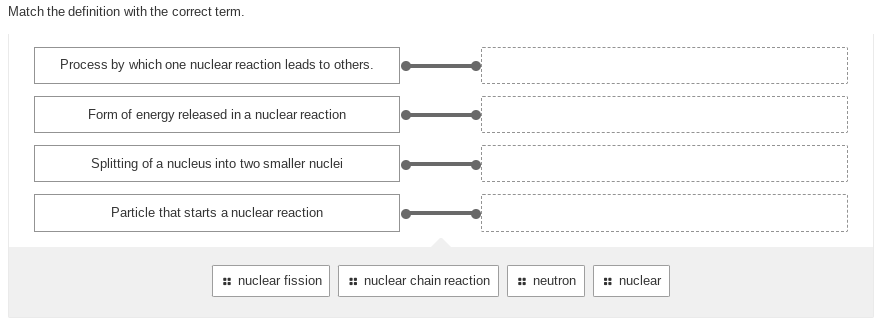Study the diagram below and put the steps in the proper order. Nuclear Power Plant Reactor 2 3 Steam Turbine Generator Water 5 Cooling water Condenser Cooling tower Image from epa.gov The steam moves through a turbine, which turns a generator to create electricity. Inside the fuel rods, uranium atoms split, releasing energy. This energy heats water, creating steam. The steam cools back into water, which can then be used over again. At some nuclear power plants, extra heat is released from a cooling tower. In a nuclear reactor, fuel rods full of uranium pellets are placed in water.
Study the diagram below and put the steps in the proper order. Nuclear Power Plant Reactor 2 3 Steam Turbine Generator Water 5 Cooling water Condenser Cooling tower Image from epa.gov The steam moves through a turbine, which turns a generator to create electricity. Inside the fuel rods, uranium atoms split, releasing energy. This energy heats water, creating steam. The steam cools back into water, which can then be used over again. At some nuclear power plants, extra heat is released from a cooling tower. In a nuclear reactor, fuel rods full of uranium pellets are placed in water.
Introductory Chemistry: A Foundation
9th Edition
ISBN:9781337399425
Author:Steven S. Zumdahl, Donald J. DeCoste
Publisher:Steven S. Zumdahl, Donald J. DeCoste
Chapter19: Radioactivity And Nuclear Energy
Section: Chapter Questions
Problem 68QAP
Related questions
Question
Study the diagram below and put the steps in the proper order and after that Match the definition with the correct term?

Transcribed Image Text:Study the diagram below and put the steps in the proper order.
Nuclear Power Plant
Reactor
2
3
Steam
Turbine Generator
Water
5
Cooling water
Condenser
Cooling tower
Image from epa.gov
= The steam moves through a turbine, which turns a generator to create electricity.
= Inside the fuel rods, uranium atoms split, releasing energy.
= This energy heats water, creating steam.
= The steam cools back into water, which can then be used over again. At some nuclear power plants, extra heat is released from a cooling tower.
= In a nuclear reactor, fuel rods full of uranium pellets are placed in water.

Transcribed Image Text:Match the definition with the correct term.
Process by which one nuclear reaction leads to others.
Form of energy released in a nuclear reaction
Splitting of a nucleus into two smaller nuclei
Particle that starts a nuclear reaction
:: nuclear fission.
nuclear chain reaction :: neutron
:: nuclear
Expert Solution
This question has been solved!
Explore an expertly crafted, step-by-step solution for a thorough understanding of key concepts.
This is a popular solution!
Trending now
This is a popular solution!
Step by step
Solved in 3 steps with 2 images

Knowledge Booster
Learn more about
Need a deep-dive on the concept behind this application? Look no further. Learn more about this topic, chemistry and related others by exploring similar questions and additional content below.Recommended textbooks for you

Introductory Chemistry: A Foundation
Chemistry
ISBN:
9781337399425
Author:
Steven S. Zumdahl, Donald J. DeCoste
Publisher:
Cengage Learning

Chemistry: Matter and Change
Chemistry
ISBN:
9780078746376
Author:
Dinah Zike, Laurel Dingrando, Nicholas Hainen, Cheryl Wistrom
Publisher:
Glencoe/McGraw-Hill School Pub Co


Introductory Chemistry: A Foundation
Chemistry
ISBN:
9781337399425
Author:
Steven S. Zumdahl, Donald J. DeCoste
Publisher:
Cengage Learning

Chemistry: Matter and Change
Chemistry
ISBN:
9780078746376
Author:
Dinah Zike, Laurel Dingrando, Nicholas Hainen, Cheryl Wistrom
Publisher:
Glencoe/McGraw-Hill School Pub Co


Chemistry: An Atoms First Approach
Chemistry
ISBN:
9781305079243
Author:
Steven S. Zumdahl, Susan A. Zumdahl
Publisher:
Cengage Learning

Chemistry
Chemistry
ISBN:
9781305957404
Author:
Steven S. Zumdahl, Susan A. Zumdahl, Donald J. DeCoste
Publisher:
Cengage Learning

Chemistry: Principles and Reactions
Chemistry
ISBN:
9781305079373
Author:
William L. Masterton, Cecile N. Hurley
Publisher:
Cengage Learning